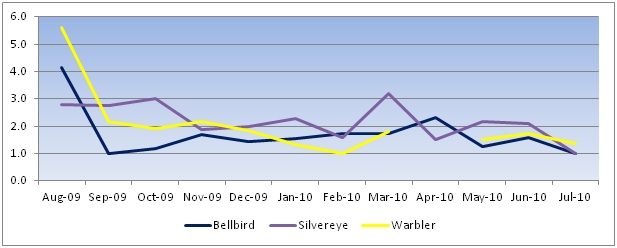Monitoring Birds in the Remutaka Forest Park
Monitoring changes in the conspicuousness of birds in the Remutaka Forest Park
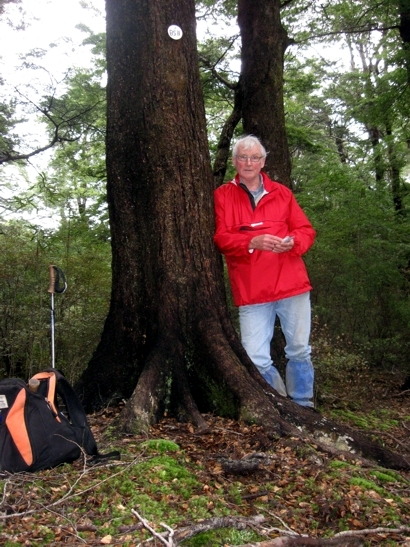
By Ian Armitage - RFPT Past President
Field monitoring of the occurrence and conspicuousness of birds occurring in the Catchpool Valley locality of the Remutaka Forest Park commenced in August 2009 by Remutaka Conservation Trust volunteers.
The purpose of monitoring is two-fold:
- To identify bird species and to note their conservation threat rankings.
- To measure changes in bird conspicuousness, seasonally and over time.
Changes in bird conspicuousness may partly be attributable to trapping efforts to reduce numbers of animal pests, especially stoats, rats and possums.
It is important to show that the Trust’s pest control work is making a positive difference for forest conservation. Regular bird monitoring is one way of doing this.
Monitoring needs to be applied consistently so that the data collected is accurate and the monitoring procedure can be replicated over time. This approach enables a local pattern of changes and trends to be established that will be helpful for conservation management.
The “five-minute count method” is used for measuring the conspicuousness of birds.
This method has been applied throughout New Zealand for over 35 years and although there have been minor changes it is still regarded as a best practice standard. A strength of the method is its simplicity.
The “five-minute count method” is regarded as an index measure of bird conspicuousness. Rather than measuring the actual density or abundance of birds directly, an index records some of the individuals present and uses this measure to infer density, or abundance.
For five-minute bird counts the relationship between the number recorded and the real density or abundance is usually unknown.
The use of this method does not result in an accurate count of all the birds present. Repeated forest observations enable comparative information about the conspicuousness of birds to be collected in different localities, and in the same locality over time.
A network of 20 count stations are located at approximately 200 metre intervals. Stations are marked on trees using numbered white plastic markers; each inscribed BS 1 to BS 20. The accompanying photo map shows the location of count stations in the beech-podocarp-tawa forest and in open land in the Catchpool Valley and on the Five-mile, Graces Stream, Middle Ridge, Clay Ridge and Butchers tracks.
Counts were made of the birds seen and heard at each station at monthly intervals from August 2009 to July 2010, also in January and February 2012. There was one night visit in January 2012. Most counts were made between 8 am and 2 pm, in fine weather and always on weekdays.
Proposed developments are an expansion of count stations along the McKerrow track and, for several months now, we have been experimenting with the use of electronic acoustic recording equipment to monitor bird calls over a longer period during the day and at night in many other areas of the Remutaka Forest Park. Thousands of hours of recordings have now been acquired for analysis.
The following photo map shows the location of 16 of our 20 count stations in the beech-podocarp-tawa forest on the Old Five-mile, Graces Stream, Orongorongo and Clay Ridge tracks.
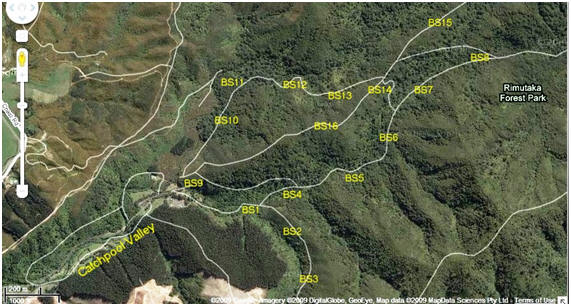
A: Summary of Results: August 2009 to February 2012
- 30 bird species recorded – 18 indigenous, 12 introduced.
- Two species were always present – bellbird & silvereye.
- Four species were recorded in 9 months out of 12 – tui, North Is fantail, grey warbler, chaffinch.
- The eight most conspicuous species are (in descending order): silvereye, bellbird, grey warbler, tui, chaffinch, NZ pigeon, North Is fantail, blackbird.
- Eight species were counted fewer than six times, namely: starling, sulphur-crested cockatoo, spur-winged plover, mallard hybrid-x, NZ pipit, harrier, welcome swallow, a parakeet species (possibly red crowned parakeet).
Habitat summary (in descending order of conspicuousness):
- A: Beech-podocarp-tawa forest habitats
- Indigenous birds – 13 species:
- Silvereye, Grey warbler, Whitehead, Bellbird, Tui, Kereru (wood pigeon), North Island tomtit North Island fantail, Shining Cuckoo, Paradise Shelduck, Long-tailed cuckoo, Kingfisher, Harrier.
- Introduced birds – 7 species:
- Sulphur-crested cockatoo. Song thrush, Goldfinch, Chaffinch, Blackbird, Eastern rosella, Dunnock.
- Indigenous birds – 13 species:
- B: Open valley and marginal forest habitats
- Indigenous birds – 12 species:
- Silvereye, Kereru (wood pigeon), Spur-winged Plover, Bellbird, Tui, NZ Pipit, Paradise shelduck, Grey warbler, North Island fantail, Harrier, Shining cuckoo, Kingfisher.
- Introduced birds – 12 species:
- Sulphur-crested cockatoo, Mallard x Grey duck (hybrid), Californian quail. Chaffinch, Goldfinch, Yellowhammer, Dunnock, Blackbird, Eastern Rosella, European starling, Song thrush, Australian Magpie
- Conservation Threat Rankings (“At Risk”) – 3
species:
- long-tailed cuckoo, NZ pipit, red-crowned parakeet (if present).
- Indigenous birds – 12 species:
B: Relative Conspicuousness:
- Total counts, 29 bird species in all habitats
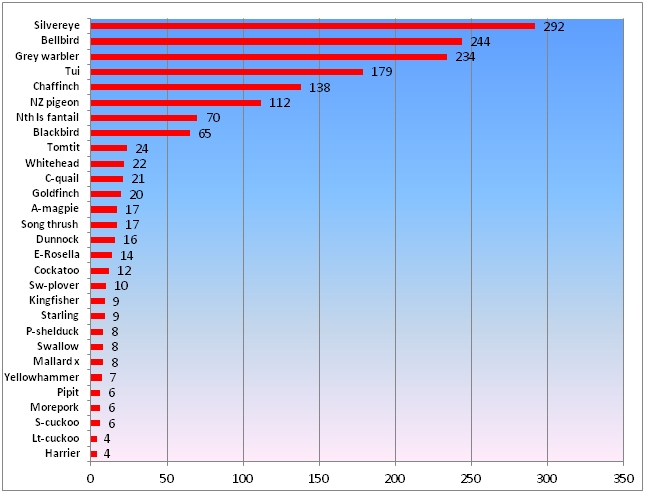
- Forest habitats, 13 indigenous species (Av. 5-min counts, August 2009 – July 2010)
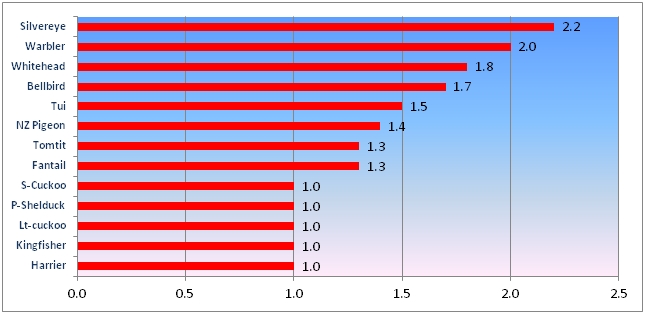
-
Forest habitats: 7 introduced Bird Species (Av. 5-min counts, August 2009 – July 2010)

- Open valley & marginal forest habitats: 12 indigenous species (Av. 5-min counts, August 2009 – July 2010)
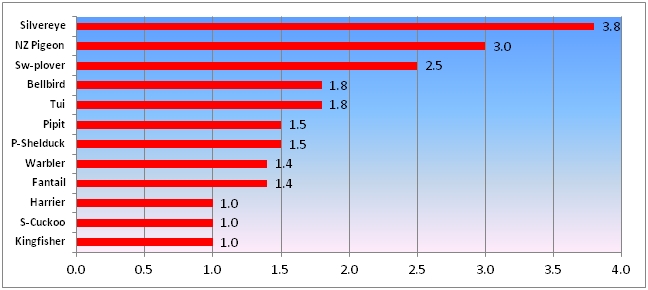
- Open valley & marginal forest habitats: 12 introduced species (Av. 5-min counts, August 2009 – July 2010)
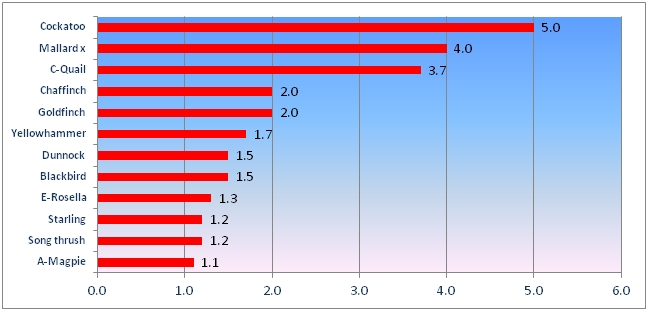
- Variation in average 5-min counts for bellbird and tui in valley and marginal forest habitats.
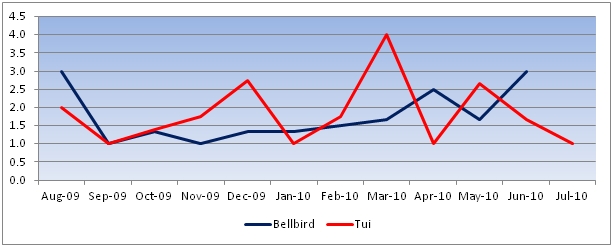
- Variation in average 5-min counts for bellbird, silvereye and grey warbler in the forest habitats.
